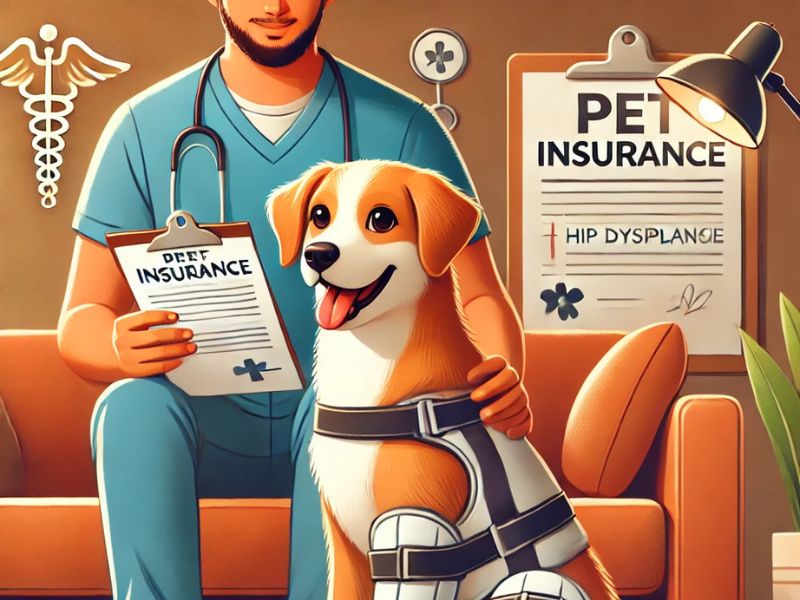Key Points:
- Hip Dysplasia Overview: Hip dysplasia is a common condition, especially in large dog breeds, causing pain and mobility issues.
- Pre-Existing Conditions in Insurance: Most insurers classify hip dysplasia as a pre-existing condition if diagnosed before the policy starts.
- Challenges in Coverage: Many pet insurance plans exclude pre-existing conditions, but some options may still provide partial or conditional coverage.
- Why It Matters: Proper insurance or financial planning can make a huge difference in managing the high costs of hip dysplasia treatments.
- Supportive Care Options: From physical therapy to lifestyle adjustments, there are several ways to improve your pet’s quality of life with or without insurance.
Understanding Hip Dysplasia in Pets
What Is Hip Dysplasia?
Picture your dog or cat trying to walk, but their hip joint doesn’t fit properly into the socket. That’s hip dysplasia—a painful condition often seen in larger dog breeds like Labradors or German Shepherds.
Over time, it can lead to arthritis, making it tough for your pet to move around comfortably.
It’s not something that just pops up one day. Hip dysplasia is usually genetic, but factors like poor diet, rapid growth, or lack of exercise can make it worse.
Why It’s a Big Deal for Pet Owners
No one likes to see their furry friend in pain, right? The tricky part about hip dysplasia is the cost of managing it.
Surgeries, medications, physical therapy—these treatments can burn a hole in your wallet faster than you’d expect. That’s why having insurance that covers this condition is a lifesaver.
What Is Pre-Existing Condition Coverage?
Defining Pre-Existing Conditions in Pet Insurance
In simple terms, a pre-existing condition is any illness or injury your pet already had before you signed up for insurance. Think of it like trying to buy car insurance after you’ve had an accident—it’s a tough sell.
When it comes to pet insurance, pre-existing conditions are a common exclusion. Most insurers won’t cover illnesses or injuries diagnosed or noticed before your policy starts.

Challenges with Pre-Existing Conditions
Here’s where it gets tricky: hip dysplasia can often be detected early, even before symptoms show up. This means if your vet noted any signs, insurers might flag it as a pre-existing condition. Frustrating, isn’t it?
However, some insurance providers have started to ease up on their policies. A few will offer coverage for curable pre-existing conditions after a waiting period.
Sadly, hip dysplasia typically falls under the “incurable” category, so finding coverage takes some extra effort.
Pet Insurance and Hip Dysplasia
Is Hip Dysplasia Considered Pre-Existing?
In many cases, yes. If your vet has already flagged it in your pet’s records before you sign up for insurance, it’s considered pre-existing.
But here’s the good news: some insurers offer partial or conditional coverage, especially if your pet has been symptom-free for a specific period.
According to Dr. Sarah Harper, a veterinary insurance consultant, “Pet insurance for pre-existing conditions is evolving. Some insurers are beginning to cover conditions like hip dysplasia if the pet has been symptom-free for a period. Pet parents should thoroughly investigate policy terms.”
Why Some Pet Insurers Avoid Covering It
Insurance companies are like businesses—they’re trying to minimize risk. Covering a chronic, expensive condition like hip dysplasia isn’t in their best financial interest unless you pay higher premiums.
This doesn’t mean you’re out of luck, though. It just means you need to shop smart.
How to Find Pet Insurance for Hip Dysplasia
Steps to Locate the Right Policy
- Research Extensively: Look for insurers with flexible pre-existing condition policies.
- Ask Questions: Call customer service to clarify what’s covered and what isn’t.
- Read the Fine Print: Check exclusions and waiting periods thoroughly.
- Get a Vet’s Input: Your vet might know of insurers that cater to pets with chronic conditions.
Companies That May Offer Coverage
A few companies have made strides in covering pre-existing conditions:
- Pet Assure: Technically not insurance but offers discounts on vet bills.
- Embrace Pet Insurance: Covers curable pre-existing conditions after a waiting period.
- Trupanion: Doesn’t cover pre-existing conditions but offers great support for new conditions.

Benefits of Pet Insurance Covering Pre-Existing Conditions
Financial Peace of Mind
Imagine not having to stress over a $5,000 surgery bill. Insurance can take that load off your shoulders, letting you focus on your pet’s recovery.
Better Care Options
With coverage, you won’t have to compromise on treatments. Whether it’s surgery, hydrotherapy, or medications, your pet can get the best care available.
Limitations and Caveats to Know
Waiting Periods and Special Conditions
Even if you find an insurer willing to cover pre-existing conditions, there are usually strings attached. Many policies come with waiting periods, meaning coverage won’t kick in immediately.
For example, some plans might require your pet to be symptom-free for six to twelve months before they’ll even consider covering hip dysplasia.
Insurers may also limit the type of treatments they’ll cover. For example, they might pay for medications or physical therapy but not for costly surgeries.
It’s like having a safety net, but with a few holes in it—you’re protected, but only to an extent.
Coverage Caps
Some policies impose caps on how much they’ll pay out annually or over your pet’s lifetime. If your pet’s care exceeds that amount, you’ll have to cover the rest out of pocket.
It’s essential to weigh whether these limitations make the policy worthwhile for your specific needs.

Tips for Managing Hip Dysplasia Costs Without Insurance
Budgeting for Treatments
If insurance isn’t an option, don’t panic. Start by creating a budget for your pet’s care. Talk to your vet about the expected costs of managing hip dysplasia and prioritize treatments based on urgency and effectiveness.
Breaking down expenses into monthly or quarterly installments can make things more manageable. Think of it like a savings plan for your pet’s health—it’s proactive and gives you peace of mind.
Exploring Payment Plans
Many vets offer payment plans for expensive treatments. These plans allow you to spread the cost over several months, making it easier to afford surgeries, medications, or therapies.
Some clinics also work with third-party financing companies that specialize in pet care loans.
How to Support Your Pet with Hip Dysplasia
At-Home Care Tips
Even without insurance, there’s a lot you can do to help your pet live a happy life. Start with their environment. Place non-slip mats on floors to prevent falls, and invest in an orthopedic pet bed to reduce joint pressure.
Nutrition plays a huge role, too. High-quality joint supplements with glucosamine and chondroitin can work wonders.
Think of these supplements as a daily dose of oil for a squeaky wheel—they won’t fix the problem entirely, but they’ll make things run smoother.
Pet care websites like the American Kennel Club recommend orthopedic beds, anti-slip mats, and joint-friendly diets to manage mobility challenges at home.
Physical Therapy and Exercise
Low-impact exercises, like swimming or short, controlled walks, can help strengthen your pet’s muscles without straining their hips. Your vet or a pet physical therapist can guide you on the best exercises for your furry friend.
Massage therapy and heat packs can also provide relief on bad days. Remember, a little TLC goes a long way in keeping your pet comfortable and happy.
Conclusion and Next Steps
Hip dysplasia can feel like a daunting diagnosis, but it’s not the end of the world. Whether you opt for insurance or manage costs independently, what matters most is providing your pet with the care and comfort they deserve.
If you’re looking for insurance, start researching companies that specialize in pre-existing conditions, ask lots of questions, and don’t hesitate to negotiate.
And if insurance isn’t an option, explore alternatives like payment plans, savings accounts, or vet-recommended treatments.
At the end of the day, your pet depends on you—and the love and care you give them will always outweigh any financial challenges.
Common Questions About Pet Insurance and Hip Dysplasia
- Can I get pet insurance if my pet already has hip dysplasia?
Yes, but coverage options will be limited. Some insurers may exclude hip dysplasia treatments, while others might offer partial coverage under certain conditions. - How much does it cost to treat hip dysplasia without insurance?
Treatment costs can range from $300 for medications and therapy to over $5,000 for surgery. The exact amount depends on your pet’s condition and the treatment plan. - Are there any alternatives to insurance for managing costs?
Yes! Consider pet savings accounts, payment plans, or discount programs like Pet Assure to reduce the financial burden. - What breeds are most at risk for hip dysplasia?
Large breeds like German Shepherds, Golden Retrievers, and Saint Bernards are particularly prone to hip dysplasia due to their size and genetics. - Is hip dysplasia curable?
While it’s not curable, it’s manageable. With the right care, treatments, and lifestyle adjustments, your pet can still lead a happy, active life.
